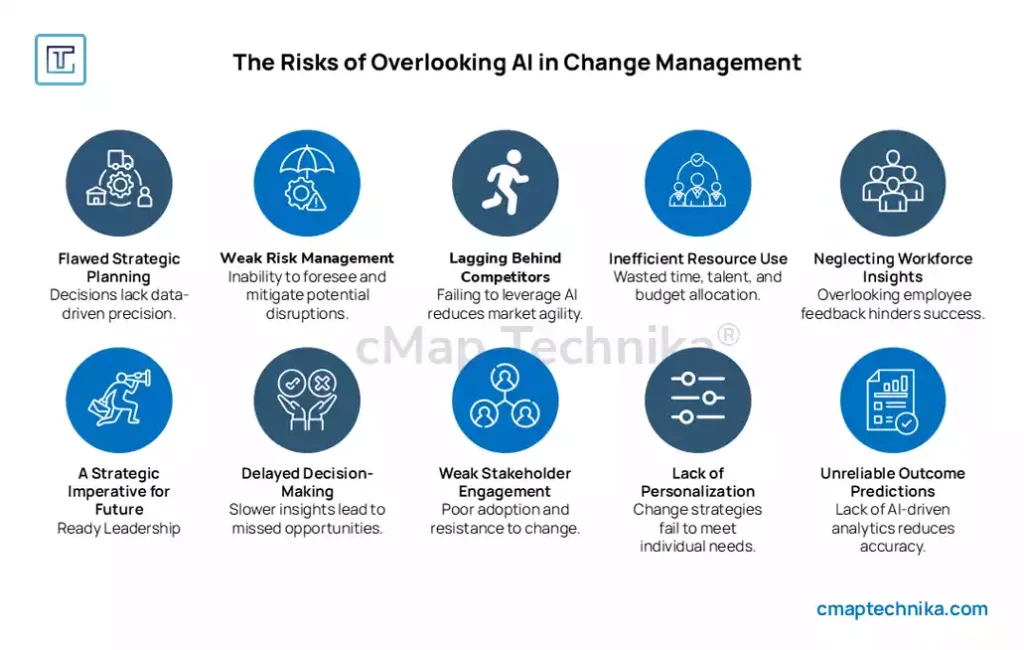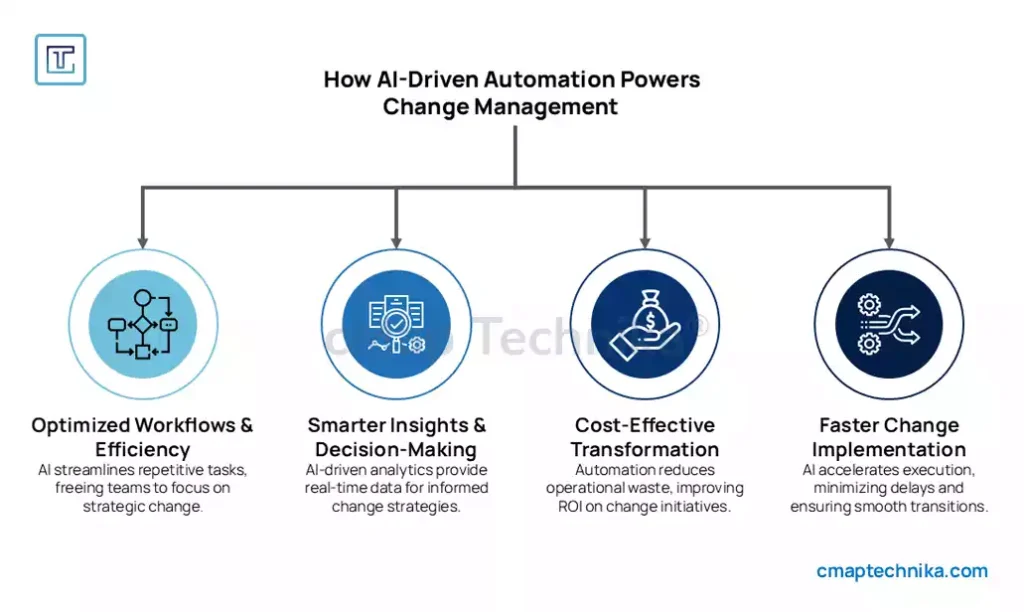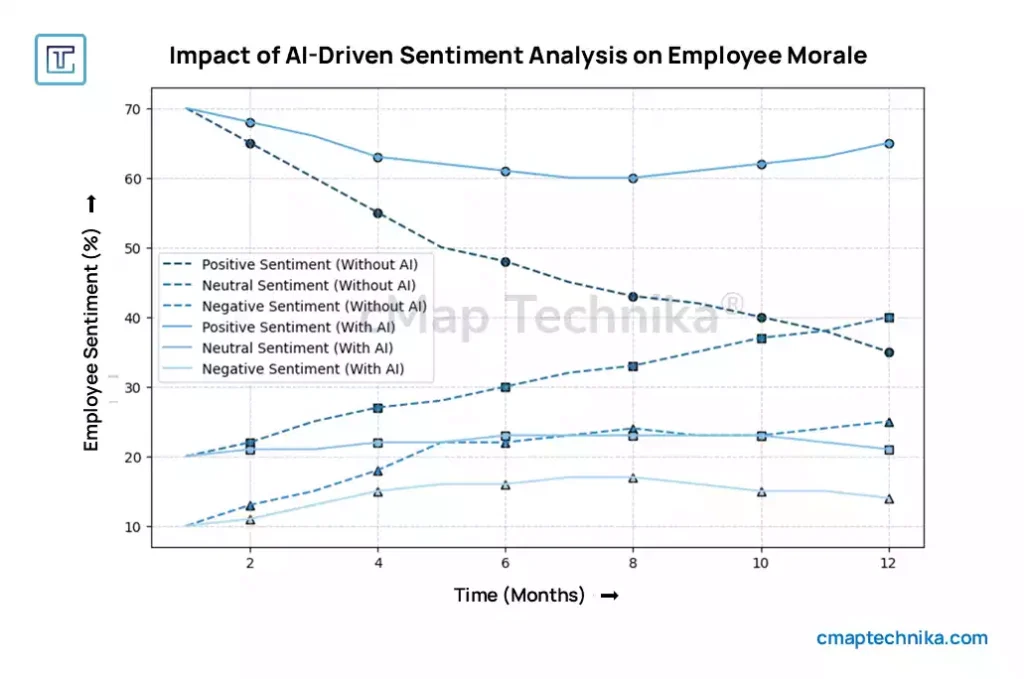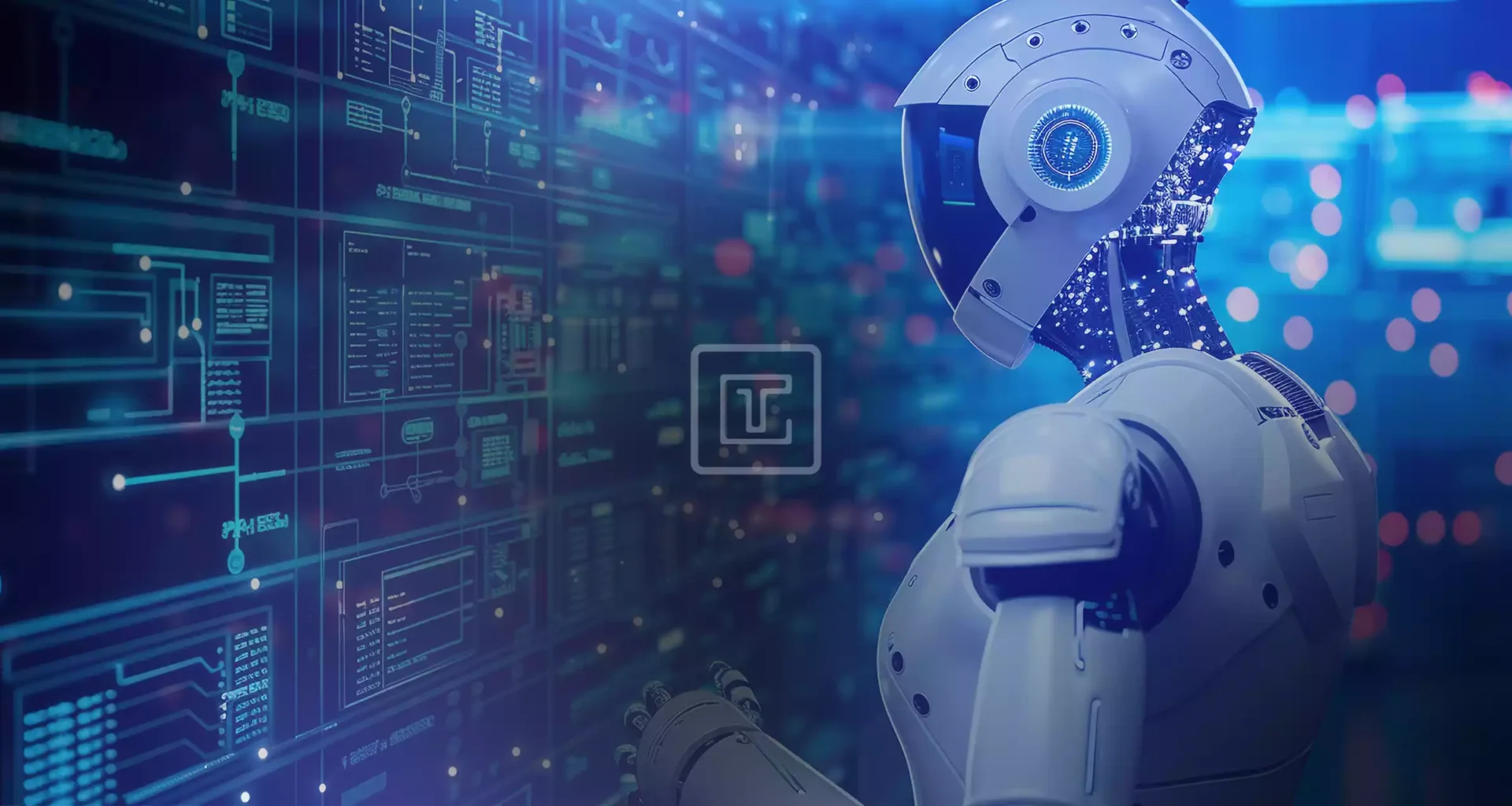Artificial intelligence is no longer just a futuristic concept—it’s the driving force behind how organizations evolve, compete, and adapt. As businesses navigate an increasingly complex and fast-paced landscape, AI is transforming change management by providing data-driven insights, predictive analytics, and automation capabilities. The question is no longer whether companies should integrate AI into their change strategies, but how they can do so effectively while maintaining momentum and employee engagement.
Understanding AI’s Role in Change Management

Traditional change management relies heavily on human intuition and static models. AI disrupts this paradigm by offering real-time data analysis, identifying potential resistance points, and optimizing the change process dynamically. By leveraging machine learning algorithms and natural language processing, organizations can better anticipate employee concerns, customize interventions, and drive smoother transitions.
AI enables organizations to shift from reactive to proactive change strategies. Instead of addressing issues as they arise, companies can foresee obstacles and develop solutions in advance. This ability to anticipate and act before disruptions occur gives businesses a significant competitive edge in an environment where adaptability is crucial.
Data-Driven Decision Making: Harnessing AI for Strategic Change
Effective change management requires more than intuition; it demands precise, data-backed decision-making. AI enables leaders to move beyond assumptions by providing real-time insights, predictive analytics, and adaptive strategies. By leveraging AI-driven intelligence, organizations can anticipate challenges, optimize resources, and refine their approach to ensure seamless transitions.
How AI Enhances Decision-Making in Change Management
- Predicting Change Outcomes with AI Modeling
AI-powered predictive models analyze historical data, employee sentiment, and behavioral patterns to forecast potential reactions to change initiatives. By understanding how employees are likely to respond, leaders can tailor their strategies to maximize engagement and minimize resistance before implementation. - Identifying Resistance Hotspots in Real Time
Machine learning algorithms detect patterns in employee feedback, communication trends, and productivity shifts to pinpoint areas of potential resistance. Instead of reacting to disruptions after they occur, organizations can take proactive steps—such as targeted communication campaigns or additional support measures—to mitigate concerns before they escalate. - Optimizing Resource Allocation for Maximum Impact
AI-driven analytics help organizations prioritize their investments by identifying which change initiatives will deliver the highest returns. Whether it’s allocating training resources, restructuring workflows, or deploying leadership support, AI ensures that efforts are focused where they will generate the greatest value.
By integrating AI-driven analytics into decision-making, organizations gain unparalleled agility, enabling them to refine their change strategies with precision. This data-driven approach not only enhances efficiency but also fosters a culture of adaptability and resilience, positioning companies for long-term success in an evolving landscape.
Personalized Change Journeys: Enhancing Engagement Through AI
Traditional, one-size-fits-all change management approaches often fail because they overlook the diverse needs, learning styles, and concerns of employees. AI-driven personalization transforms the change experience by tailoring support, training, and communication to individual employees, ensuring smoother transitions and higher engagement. When employees feel that change is designed with their needs in mind, they are more likely to embrace and contribute to it.
How AI Enhances Personalization
- AI-Powered Chatbots & Virtual Assistants
Intelligent chatbots provide real-time support, answering employee questions, clarifying new policies, and offering step-by-step guidance during transitions. These AI-driven assistants reduce uncertainty and prevent information bottlenecks by ensuring that employees always have access to reliable, on-demand assistance. - Adaptive Learning Platforms for Skills Development
AI-driven learning systems assess individual proficiency levels and curate personalized training paths. Instead of a generic training program, employees receive targeted learning modules that evolve based on their progress, ensuring they gain the necessary skills at a comfortable pace. This accelerates adaptation and prevents information overload. - Behavioral Insights for Targeted Interventions
AI continuously monitors engagement levels, communication patterns, and productivity trends to identify potential challenges before they escalate. By analyzing this data, AI can recommend specific interventions—such as additional coaching, customized resources, or manager check-ins—to support employees who may be struggling with change.
By making the change process more tailored and responsive, AI-driven personalization helps employees feel valued, heard, and supported. This reduces resistance, enhances engagement, and fosters a culture where change is seen as an opportunity for growth rather than an imposed disruption.
Automation: The Catalyst for Seamless Transitions

One of the biggest barriers to successful change management is the burden of manual, repetitive tasks that drain time and resources. AI-driven automation not only accelerates transitions but also enhances efficiency, allowing employees to focus on strategic and high-value contributions rather than getting caught up in administrative bottlenecks. When properly implemented, automation becomes a powerful enabler of smoother, more sustainable change.
Key Areas Where AI-Driven Automation Accelerates Change
- Automated Onboarding & Training
AI-powered learning systems personalize training programs, ensuring employees quickly adapt to new tools, workflows, and expectations. Interactive AI-driven modules can identify skill gaps and provide targeted learning resources, helping employees integrate into evolving roles with minimal disruption. - Workflow Optimization for Operational Efficiency
Intelligent automation reduces inefficiencies by streamlining repetitive processes, such as approvals, scheduling, and data entry. By minimizing disruptions, automation allows teams to maintain productivity during transitional periods, ensuring that change is implemented with minimal friction. - AI-Enabled Feedback Loops for Continuous Improvement
AI-powered surveys and real-time sentiment analysis provide continuous feedback on employee concerns and experiences. These insights help organizations refine their change strategies dynamically, addressing resistance and roadblocks before they escalate into larger issues.
By reducing manual workload, improving process clarity, and fostering real-time responsiveness, automation not only accelerates change but also mitigates employee frustration. Instead of feeling overwhelmed by transition phases, employees can focus on adapting, innovating, and contributing to the organization’s long-term success.
Enhancing Employee Experience Through AI
One of the biggest challenges in organizational change is overcoming resistance, which often stems from uncertainty, misinformation, or lack of engagement. AI-driven tools can bridge this gap by providing real-time insights into employee sentiment, facilitating personalized communication, and offering continuous support. When used strategically, AI can transform change management from a top-down directive into an inclusive, employee-driven process.
Best Practices for AI-Enabled Employee Engagement
- Sentiment Analysis for Real-Time Insights

AI-powered sentiment analysis tools continuously monitor employee feedback, engagement levels, and morale. By identifying patterns and detecting early signs of frustration or disengagement, leaders can proactively address concerns before they escalate, ensuring a smoother transition.
- Intelligent and Personalized Communication
Traditional change communications often fail because they are too broad or impersonal. AI-driven platforms tailor messages based on employee roles, preferences, and past interactions, ensuring that workers receive relevant updates that resonate with their needs. This targeted approach minimizes confusion and fosters a sense of inclusion. - AI-Driven Coaching and Career Support
Virtual coaching platforms powered by AI can provide employees with personalized learning paths, career development resources, and adaptive training. By aligning these tools with organizational change initiatives, companies can help employees navigate transitions with confidence while fostering a culture of continuous growth.
By leveraging AI to enhance communication, monitor engagement, and provide ongoing support, organizations can create a more transparent and inclusive change experience. Instead of employees feeling like passive recipients of change, they become active participants, leading to greater adoption, satisfaction, and long-term success.
The Ethical Considerations of AI in Change Management
AI has the potential to streamline operations, enhance decision-making, and improve workplace efficiency. However, without careful oversight, it can also introduce ethical challenges that undermine trust, transparency, and fairness. Addressing these concerns is critical to ensuring AI-driven change is both responsible and sustainable.
Key Ethical Considerations
- Bias in AI Algorithms
AI systems learn from historical data, and if that data is biased, AI can reinforce and even amplify existing inequalities. Organizations must prioritize diverse and representative datasets, regularly audit AI models for bias, and establish governance frameworks to prevent discriminatory decision-making. - Data Privacy and Security
AI systems rely on vast amounts of data, including sensitive employee information. Protecting this data is not just a legal requirement but a fundamental trust-building measure. Companies must implement robust cybersecurity protocols, ensure compliance with data protection regulations, and clearly communicate how employee data is used. - Human Oversight and Accountability
AI should serve as a tool to assist human decision-making, not replace it. Leaders must ensure that AI-driven insights align with company values, ethical principles, and the organization’s long-term vision. Establishing accountability measures and maintaining human oversight in critical decision-making processes will prevent AI from being used in ways that could harm employees or create unintended consequences.
Ethical AI adoption is not just a compliance issue—it is a competitive advantage. Organizations that embed ethical considerations into their AI-driven change strategies will foster greater employee trust, mitigate risks, and create a more inclusive and responsible digital transformation.
Leadership in the Age of AI-Driven Change
AI is revolutionizing industries, reshaping workflows, and accelerating decision-making. However, technology alone cannot drive successful transformation—strong leadership is the catalyst that ensures AI is integrated effectively, ethically, and sustainably. The challenge for leaders is not just adopting AI but fostering an environment where both technology and human potential thrive together.
How Leaders Can Steer AI-Powered Change
- Champion a Culture of Continuous Learning
AI’s rapid evolution demands an adaptable workforce. Leaders must invest in upskilling initiatives, encourage cross-functional learning, and position AI as a tool that enhances human capabilities rather than replacing them. - Foster Transparency and Inclusivity
Employees need clarity on how AI influences business operations, job roles, and decision-making. Open communication, frequent updates, and opportunities for employee feedback help reduce uncertainty and build trust in AI-driven transformation. - Integrate AI with Emotional Intelligence
While AI can improve efficiency and provide data-driven insights, leadership remains a deeply human function. Leaders must balance AI adoption with empathy, ethical considerations, and interpersonal relationships, ensuring that technology supports rather than undermines the human aspects of decision-making.
When managed effectively, AI is not a disruptive force that alienates employees—it is an enabler of innovation and efficiency. Strong, empathetic leadership is crucial to ensuring AI adoption aligns with organizational values, enhances workforce engagement, and creates sustainable value for businesses and employees alike.
Future-Proofing Organizations with AI
AI is revolutionizing change management, but success lies in more than just adopting new technologies—it requires an ongoing commitment to adaptability and innovation. Organizations that harness AI-driven insights, automation, and personalization will gain a competitive edge, while those that resist change risk falling behind.
As AI continues to evolve, the question is no longer whether businesses should integrate it into their change strategies, but how effectively they can do so. Will companies embrace AI to drive smarter, more agile transformations, or will hesitation and outdated approaches hold them back?
The future of organizational change is already unfolding. Those who take a proactive, AI-powered approach will not only navigate disruption with confidence but also set the stage for long-term success in an increasingly dynamic world.






